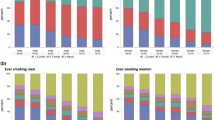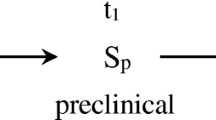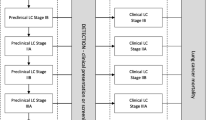Abstract
Background
The US preventive services task force (USPSTF) recently recommended that individuals aged 55–80 with heavy smoking history be annually screened by low-dose computed tomography (LDCT), thereby extending the stopping age from 74 to 80 compared to the national lung screening trial (NLST) entry criterion. This decision was made partly with model-based analyses from cancer intervention and surveillance modeling network (CISNET), which assumed perfect compliance to screening.
Methods
As part of CISNET, we developed a microsimulation model for lung cancer (LC) screening and calibrated and validated it using data from NLST and the prostate, lung, colorectal, and ovarian cancer screening trial (PLCO), respectively. We evaluated population-level outcomes of the lifetime screening program recommended by the USPSTF by varying screening compliance levels.
Results
Validation using PLCO shows that our model reproduces observed PLCO outcomes, predicting 884 LC cases [Expected(E)/Observed(O) = 0.99; CI 0.92–1.06] and 563 LC deaths (E/O = 0.94 CI 0.87–1.03) in the screening arm that has an average compliance rate of 87.9% over four annual screening rounds. We predict that perfect compliance to the USPSTF recommendation saves 501 LC deaths per 100,000 persons in the 1950 U.S. birth cohort; however, assuming that compliance behaviors extrapolated and varied from PLCO reduces the number of LC deaths avoided to 258, 230, and 175 as the average compliance rate over 26 annual screening rounds changes from 100 to 46, 39, and 29%, respectively.
Conclusion
The implementation of the USPSTF recommendation is expected to contribute to a reduction in LC deaths, but the magnitude of the reduction will likely be heavily influenced by screening compliance.




Similar content being viewed by others
References
Carbone D (1992) Smoking and cancer. Am J Med 93:S13–S17
Aberle D, Adams A, Berg C et al (2011) Reduced lung-cancer mortality with low-dose computed tomographic screening. N Eng J Med 365:395
Moyer VA (2014) Screening for lung cancer: US preventive services task force recommendation statement. Ann Intern Med 160:330–338
de Koning HJ, Meza R, Plevritis SK et al (2014) Benefits and harms of computed tomography lung cancer screening strategies: a comparative modeling study for the US preventive services task force. Ann Intern Med 160:311–320
Meza R, Haaf K, Kong CY et al (2014) Comparative analysis of 5 lung cancer natural history and screening models that reproduce outcomes of the NLST and PLCO trials. Cancer 120:1713–1724
Han SS, ten Haaf K, Hazelton WD et al (2017) The impact of overdiagnosis on the selection of efficient lung cancer screening strategies. Int J Cancer. doi:10.1002/ijc.30602
Meza R, Hazelton WD, Colditz GA, Moolgavkar SH (2008) Analysis of lung cancer incidence in the nurses’ health and the health professionals’ follow-up studies using a multistage carcinogenesis model. Cancer Causes Control 19:317–328
Moolgavkar SH, Venzon DJ (1979) Two-event models for carcinogenesis: incidence curves for childhood and adult tumors. Math Biosci 47:55–77
Hazelton WD, Luebeck EG, Heidenreich WF, Moolgavkar SH (2009) Analysis of a historical cohort of Chinese tin miners with arsenic, radon, cigarette smoke, and pipe smoke exposures using the biologically based two-stage clonal expansion model. Radiat Res 156:78–94
Lin RS, Plevritis SK (2012) Comparing the benefits of screening for breast cancer and lung cancer using a novel natural history model. Cancer Causes Control 23:175–185
Tan S, Van Oortmarssen GJ, De Koning HJ, Boer R, Habbema JDF (2006) The MISCAN-Fadia continuous tumor growth model for breast cancer. Monogr-Natl Cancer Inst 36:56
Lindell RM, Hartman TE, Swensen SJ et al (2007) Five-year lung cancer screening experience: CT appearance, growth rate, location, and histologic features of 61 lung cancers1. Radiology 242:555–562
MacMahon H, Austin JH, Gamsu G et al (2005) Guidelines for management of small pulmonary nodules detected on CT scans: a Statement from the Fleischner society1. Radiology 237:395–400
Ginsberg R, Hill L, Eagan R et al (1983) Modern thirty-day operative mortality for surgical resections in lung cancer. J Thor Cardiovasc Surg 86:654
Oken MM, Hocking WG, Kvale PA et al (2011) Screening by chest radiograph and lung cancer mortality. JAMA. 306:1865–1873
Rockhill B, Spiegelman D, Byrne C, Hunter DJ, Colditz GA et al (2001) Validation of the Gail, model of breast cancer risk prediction and implications for chemoprevention. J Natl Cancer Inst 93:358–366
Holford TR, Clark L (2012) Development of the counterfactual smoking histories used to assess the effects of tobacco control. Risk Anal 32:S39–S50
McMahon PM, Meza R, Plevritis SK, et al. (2014) Benefits from lung cancer screening: Extrapolating from the NLST to other designs and participants. PLoS ONE
McMahon PM, Kong CY, Bouzan C et al (2011) Cost-effectiveness of CT screening for lung cancer in the US. J Thor Oncol 6:1841
Author information
Authors and Affiliations
Corresponding author
Electronic supplementary material
Below is the link to the electronic supplementary material.
Rights and permissions
About this article
Cite this article
Han, S.S., Erdogan, S.A., Toumazis, I. et al. Evaluating the impact of varied compliance to lung cancer screening recommendations using a microsimulation model. Cancer Causes Control 28, 947–958 (2017). https://doi.org/10.1007/s10552-017-0907-x
Received:
Accepted:
Published:
Issue Date:
DOI: https://doi.org/10.1007/s10552-017-0907-x




